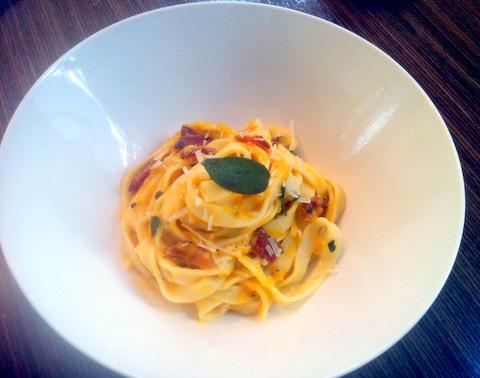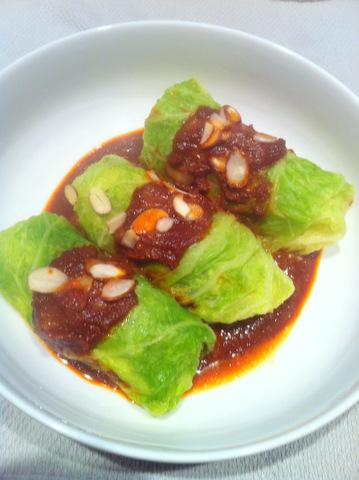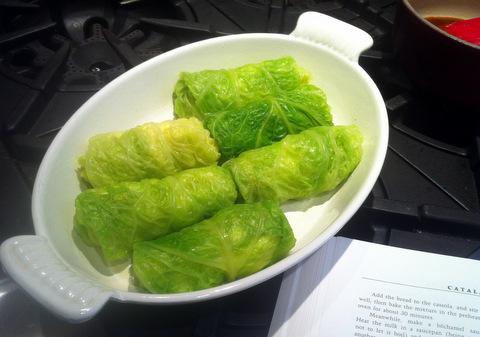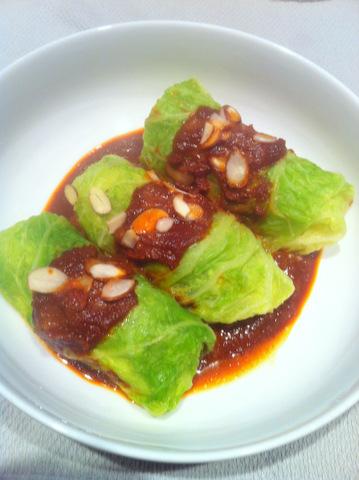
LindaK
eGullet Society staff emeritus-
Posts
3,028 -
Joined
-
Last visited
Content Type
Profiles
Forums
Store
Help Articles
Everything posted by LindaK
-
Anthemoney, You should read through the many week-long food blogs that eGullet has hosted. Lots of insight into how members from various culinary cultures cook at home. Plus the many questions/comments they get will certainly tell you something about what others want to know about the cooking and the culture. Index and links here. good luck!
-
Good luck! I lived in DC and Baltimore for years and remember well the panic and bad driving with just an inch or two of snow. But this is a real one. I hear that we (Boston, that is) are sending some snow removal equipment your way. We’re lucky that this storm is mostly missing us, but the food hoarding instinct still kicks in. What did you think of the capon? I’ve never tasted one. I hope you’re planning on making some stock/broth with the carcass and meat scraps. Though I don’t cook meat often, I generally grab a chicken on a pre-storm grocery run. A roast, leftovers for sandwiches, and then a good soup—that’s generally part of my storm cooking strategy.
-
The last time I bought a whole duck, it was to make 3 recipes from David Lebovitz’s My Paris Kitchen: Counterfeit Confit (see here), a rustic duck terrine (see here) and the surprisingly delicious duck fat cookies: I would recommend the counterfeit confit if you want a quick, easy and delicious version of the classic dish. Duck terrine is a god idea, but not this recipe.
-
Franci, lovely ravioli! Can you share your technique for filling and cutting them so uniformly? I don't have any problems making the pasta, but my ravioli always look a little sloppy. btw, I really enjoyed the videos you posted on the previous page. I've never seen anyone roll such large pasta sheets before. masterful.
-
Lime is my citrus juice of choice for ceviches and salsas. Lots of room for creativity there. It's also pretty standard to add a squeeze of lime to Mexican soups, and the few Asian soups (Vietnamese and Cambodian) I know about. if you decide to make something to gift, lime marmalade and lime curd are delicious.
-
I was just browsing the ChefSteps site that's been mentioned. It seems that their Joule is on sale for $199 (reg $299) until Jan 15. The catch is that it doesn't ship until May.
-
Blue, I don;t know where Santa found the PureFizz. Good to know about SodaPlus if I decide that I need a cold canister available at all times! I thought the wine was fine pre-fizz, but the flavor had changed with addition of CO2. I'm going to try getting it colder too, maybe the hour in the fridge wasn't enough.
-
Now that I have a PureFizz, I’m ready to join the MR fan club. I’ve now tried it once with Monsieur Rotuts’ preferred TJ cuvée with okay but underwhelming results. I saw lots of little bubbles but somehow they didn’t register on the palate, if that makes sense. A bit of a sour flavor. Luckily Santa also gave me a few boxes of the CO2 cylinders so I’m ready to try again. My PureFizz came with minimal directions on the packaging and a few tips in the enclosed “recipe” book. I learned more from reading here and in MC but still have a few questions. According to the PureFizz info, the bubbles get smaller the more you shake the bottle. Has anyone worked out the optimal number of shakes? I got very small bubbles but no bubble sensation in the drinking, so perhaps I was over-enthusiastic. PureFizz also says that the more you let the bottle sit, the fizzier it gets. How long do others let it rest after adding the CO2? MC recommends an hour, but from what I’ve read here, no one waits that long for MR. Also wondering if the “sour flavor” is a matter of finding the right still wine for my palate, or is it something in my technique? I do not own a Baccarat flute. Perhaps that is the problem.
-
Craving something light after all the rich holiday fare. Tired of shopping but I had plenty of odd bits in the fridge and freezer so decided to make use of what was at hand. The result was a vaguely Asian chicken soup with spaghetti squash subbing for the usual noodles. I simmered some fresh ginger and lemongrass with the broth. Very nice. The spaghetti squash fit right in.
-
A PureFizz soda maker. I see some Methode Rotuts in my future, once I can get to Trader Joe’s for the base ingredient.
-
I’ve had this problem too. Here’s what I think was happening: When rolling the balls of dough, after the first dozen or so, inevitably my palms end up coated with a thin layer of chocolate—which means the balls of dough have a light sticky layer of this melted (or at least higher temp) dough on the exterior. I think this makes a difference to the confectionary sugar coating. Whether it melts more readily or gets absorbed into the dough, I don’t know. But inevitably some of my cookies were like yours. My assembly line technique used to be: roll a ball of dough, roll in confectionary sugar, place on cookie sheet. Continue til finished. Hold unbaked sheets in fridge. What I now do: roll all the dough balls without coating them in confectionary sugar, put them on a cookie sheet and into the fridge to chill for a few minutes. When it’s time to bake, take from the fridge enough dough balls for a batch, roll them in confectionary sugar, then put the sheet straight into the oven. It doesn’t take any more time. For me, it’s solved the problem. Here’s the batch I made yesterday (sorry for the poor lighting, but it's the cookies that matter ;-)
-
Desert Rain Café, Sells, AZ (Tohono O'odham Nation)
LindaK replied to a topic in Southwest & Western States: Dining
Thanks for this review. During a trip to Phoenix a few years ago I tried (but failed) to fit in a side trip to the Kitt Peak National Observatory. They have visitor programs with access to their telescopes, including nighttime sky observations that I’ve heard are amazing. Even without telescopes, the nighttime sky at 7,000 ft (with minimal light pollution) has to be gorgeous. For visitors like me who don’t know the area, the map of the observatory in the midst of the vast expanse of Tohono O'odham land makes the trip seem a little intimidating. The observatory’s visitor center website cautions that there is no gas or food nearby. So it’s nice to know about the Desert Rain Café and other reasons to visit this beautiful area. Observatory: https://www.noao.edu/kpno/ VisitorCenter: http://www.noao.edu/kpvc/ -
Butternut Squash Carbonara with homemade fettuccini Not a traditional carbonara (no eggs) but very satisfying nonetheless. The base is a puree of squash, sauteed onions and garlic w/ some broth. Add crisped pancetta (or bacon, if you wish) along with some grated parmesan cheese and fresh sage, a bit of the pasta cooking water to thin the sauce. The fresh pasta absorbs the sauce beautifully and results in a pretty, saffron colored dish. Frying the sage leaves until crispy in the pancetta fat is a great trick, I love fried sage. I crumbled most of it into the sauce but saved a leaf for garnish. A good excuse to make some homemade pasta!
-
French cuisine cookbook in English for Papua-New Guinea.
LindaK replied to a topic in Cookbooks & References
It sounds like a book that’s focused on easy recipes is more appropriate for your friends. I’m all for teaching fundamental techniques, but that isn’t where everyone wants/needs to start. Of the many French cookbooks on my shelf, my personal favorite of this sort would be Patricia Wells’ Bistro Cooking. It’s a good collection of traditional French classics. She prefaces each recipe with a short story, but your friends can ignore those if they choose and focus on the recipes, which are mostly very straightforward and clearly written. Recipes also include metric weight/volumes so they would not need to worry about converting from the US/Imperial system. No photos, if that matters, but there are helpful menu suggestions. Another suggestion would be Ina Garten’s Barefoot in Paris. It’s a much shorter book with extremely simple recipes. This book was a gift and I’ve never actually used it because it’s just too basic for my needs and experience. But the recipes look reliable and couldn’t be easier. Lots of photos. All US/Imperial measures, no metrics, alas. Amazon lets you preview both books. The preview of the Garten book shows more intro text than recipes. The preview of the Wells book includes the index so you can see the range of recipes. -
Nancy, I don’t have a knowledgeable answer to your gravy question, but I’ll give it some thought and maybe do some reading.. Back to your oyster recipe—when I looked at your link and saw that the recipe in question was for Oysters à la Marinière, I was puzzled as I’d never heard of using a flour thickener in a marinière before. And come to think of it, I’d never heard of oysters marinière. A quick search not only turned up the recipe, but a video of the chef at Commander’s Palace making the recipe! (from the excellent old TV series Great Chefs) http://greatchefs.com/recipes/oysters-mariniere/ Two quick takeaways: very low flour to butter ratio, and specific instructions to cook the sauce only 30 seconds after adding the buerre manié.
-
A buerre manié serves two purposes: to thicken an integral sauce--one made with resulting natural cooking juices, as with a braise--at the end of cooking, when you can't make a separate sauce such as a bechamel or velouté that starts with a cooked roux. The latter is what TFTCrepes describes. mixing the flour with the butter prevents it from lumping when added to the hot liquid. The ratio I learned was 1 Tbsp each butter and flour to 1 cup liquid. It needs to be brought to a simmer before you see any thickening so add it slowly so you don't overdo it. Somewhere along the way I learned that when using a buerre manié, either stop cooking the sauce once it thickens or that it needs a long, slow cooking afterwards (such as with a coq au vin). Out of curiousity, I consulted James Peterson's great book Sauces and here's what he says about buerre manié: Unlike roux, buerre manié should not be cooked any longer once the mixture thickens, or the sauce will develop a strong floury taste. One of the peculiarities of flour is that it develops a strong floury taste after two minutes of cooking that begins to disappear as the cooking progresses, usually after thirty minutes. edited for typos
-
Smoked fish as part of a composed salad would be lovely and special. Or a soup, maybe a fish chowder.
-
One of the reasons I like the Paula Wolfert oven method is that there are never lumps, it's always very creamy. The cornmeal is added to cold water. I usually use medium grain cornmeal because I like some texture to the polenta. But I still want it toothsome, no grit or crunch. The oven method lets me have it both ways. I'm telling you, it's great.. I don't see why not, the principle is the same--long, slow cooking. I've never used one so can't offer any advice on time or temperature. It's worth trying. Just oil the pan inside. Start with cold water.
-
-
The best—and easiest—way to get great polenta is to take Paula Wolfert’s advice and cook it in the oven. Oil your casserole, add water (and milk if you wish), polenta, some salt, a bit of butter, and bake at 350F for about 50 minutes. No stirring necessary. Really. The long, slow cooking makes the creamiest polenta ever. Since trying this, I’ve rarely made it on the stove and when I have, I’ve regretted it, it’s never as good. I first saw the instructions in Wolfert’s cookbook The Slow Mediterranean Kitchen but you can also find it here.
-
Kenneth, I’m envying your trip. Vietnam is on my shortlist of places to visit. Some additional reading that might be helpful: On her blog Viet World Kitchen, Andrea Nguyen recently mentioned some restaurants and bahn mi joints that she enjoyed in Saigon, here and here. Blog Stickyrice, covering the Hanoi food scene Culinary tour business Hanoi Street Food Tours is interesting reading, even if you don’t want a tour.
-
Lisa, I love the sound of your vegetarian cabbage rolls. When I stuff grape leaves with a vegetarian filling, I usually add currants and toasted pine nuts. They add lots of flavor and texture. Reposting this photo from the Salt Cod topic: Stuffed Cabbage with Salt Cod, from Colman Andrews’ Catalan Cuisine. I never would have thought of stuffing cabbage with fish, much less salt cod. The filling is brandade, a smooth, creamy puree of salt cod, olive oil, cream. These are lighter than cabbage rolls with meat but they are very rich. The sauce is strongly flavored with ancho chile, roasted red pepper, as well as tomato. One interesting thing that might be useful for other stuffed cabbage recipes: the stuffed rolls were cooked in the oven without the sauce. When they came out of the oven the cabbage leaves were still very green and firm, much more so than you’d get after simmering them in sauce. See the photo below. Since the filling here was already cooked, the rolls only needed to be reheated. But I wonder what would happen if I tried this with the usual raw ground meat. I can say that I liked the flavor of these better when I reheated the leftovers with the sauce. But the greener, firmer cabbage might make cooked rolls better for freezing. I may experiment the next time I make traditional stuffed cabbage.
-
The revival of the Stuffed Cabbage cook-off made me remember this recipe from Coleman Andrews’ Catalan Cuisine: Stuffed Cabbage with Salt Cod. It’s pretty straightforward, blanched cabbage leaves filled with brandade—no potatoes, just salt cod, garlic-flavored olive oil, and cream. Rather than a simple tomato sauce, he offers a sauce that uses dried (ancho) chile, roasted red pepper, and tomato. It’s got a deep, complex taste that holds up to the strong flavors of cabbage and salt cod. Slivered almonds for garnish. When I make this again, there are a few small things I’d do differently. - Andrews calls for a smooth brandade, which makes the dish rather refined. I’d prefer to have some texture and pops of flavor that would come from a chunkier filling. - The olive oil in the brandade is infused with garlic, but Andrews discards the garlic before adding it to the fish. I‘d leave some of the garlic in there, its flavor was really lost in the final dish. - Also, the filled cabbage rolls were heated in the oven without the sauce. It made for a prettier presentation, but I didn’t find the flavors really came together as they should. When I reheated leftovers the next day in the sauce, I liked this recipe much better!
-
david, if you decide to use flour, I was happy with the results of using nut flour in my fritters. It added flavor that really complimented the squash, But I don't know enough about the properties of nut flours to know if they would suit your purpose. Another idea would be to mix the puree with some ricotta. Really fresh ricotta is somewhat dry, so it adds body without adding much moisture. Its mild flavor won't compete with the squash. Nice with a sweet dough.
-
I find this to be true no matter what detergent I buy, especially the awful "orange" scents. Fortunately, I only taste it when I lick the spatula (sorry, I do that!), it doesn't leach into the full pot of food/sauce. I'm still looking for a good detergent without a strong scent.







